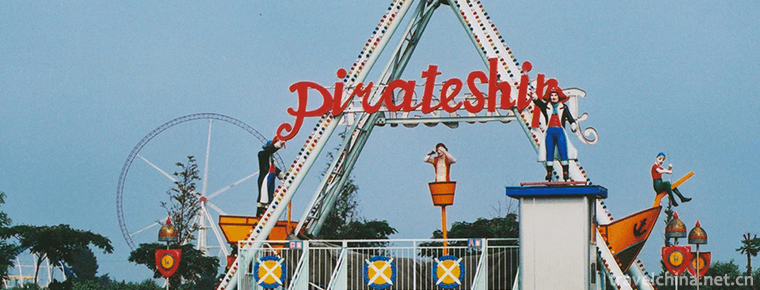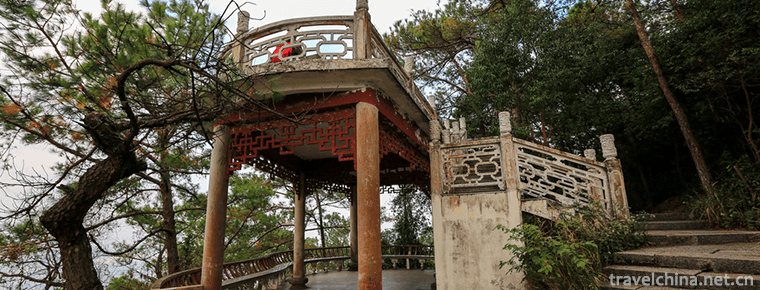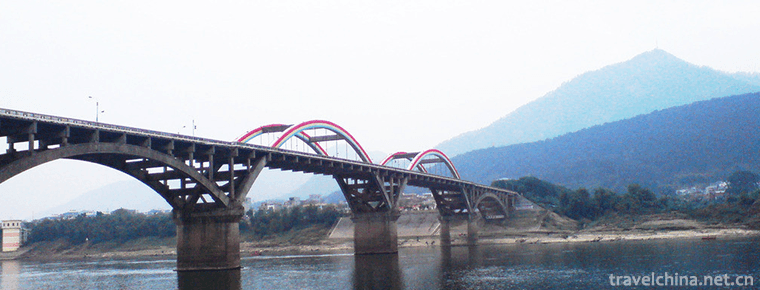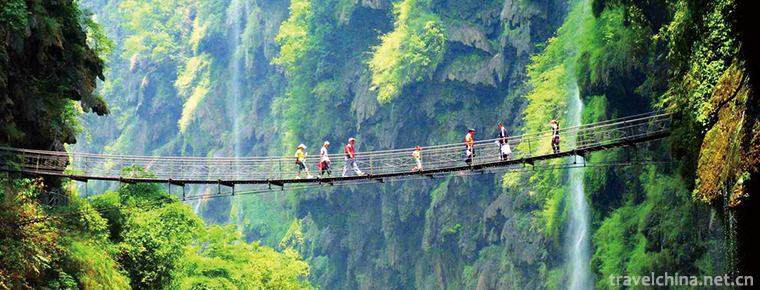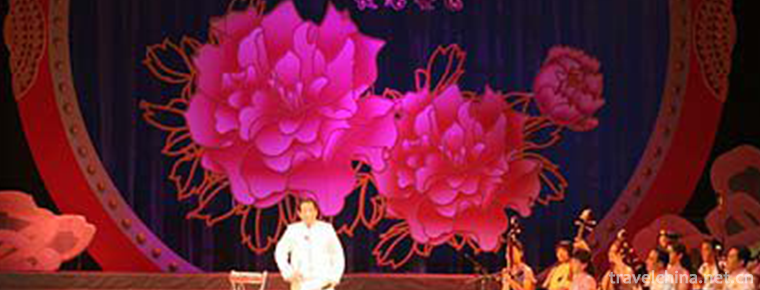Mount Tianzhu Scenic Area
Tianzhu Mountain Scenic Spot, located in the west of Qianshan City, Anqing City, Anhui Province, is known as "the first mountain in the Yangtze River and Huaihe River" for its main peak, such as "Optimum Heaven Pillar". There are mainly Tianzhu Peak, Feilai Peak and Tianchi Peak. There are 45 peaks above 1000 meters, the main peak is 1488.4 meters above sea level, and the planned protected area of the scenic spot is 333 square kilometers. The area of the scenic spot is 82.46 square kilometers.
Tianzhu Mountain Scenic Area is one of the three famous mountains in Anhui Province (Huangshan, Jiuhua Mountain, Tianzhu Mountain). The religious culture of the scenic spot is deeply accumulated, and it is one of the birthplaces of Zen Buddhism in China. The third generation of Zen ancestors, Sanghuang, are stationed here in Xihongfa to inherit clothes and bowls. Sanzu Temple has been sealed by emperors of all dynasties for many times, and enjoys the reputation of "who is the first in the Zen forest, and this place is crowned Nanzhou". There are some precious cultural relics such as "Unbound Stone", "Sanzu Shrita" and "Sanzu Cave".
In 1982, it was approved by the State Council as the first batch of national key scenic spots. In 1992, it was approved as National Forest Park. In 2000, it was rated as the national AAAAA tourist attraction, and in 2011, it was approved as the World Geopark.
Tianzhu Mountain had no special administrative organization before the Republic of China. The development and construction of Tianzhu Mountain was limited to temples and pavilions. Most of the visitors were hosted by temples.
In the 31st year of the Republic of China (1942), Fan Yuansheng, Inspector General of the Anqing Administration, advocated the establishment of the Tianzhu Mountain Development Committee, and received funding from the Anhui Provincial Government and social donations, raising nearly one million yuan (French currency). Because of the social unrest at that time and other reasons, only Yueyun Mountain Hall, Cuiyun Villa and a simple climbing trail (Liangyaoping to Tianzhu Peak) were built.
In 1958, Tianzhu Mountain Forest Farm was established, and a large number of plantations were built. Among them, there are 8,000 Mu bamboo sea in Beiguanzhai, thousands of Mu fir forest in Tongluojian, Liangyaoping and Nanguanzhai.
In 1982, with the approval of the State Council, Tianzhu Mountain was identified as the first batch of national key scenic spots. In November of the same year, Tianzhu Mountain Landscape Management Office was established.
In 1986, it was transformed into Tianzhu Mountain Administration Office of Anhui Province, which has six units under its jurisdiction: Tourism, Landscape Architecture, Infrastructure, Accounting and Finance. The state has invested 2.58 million yuan in seven hydropower stations, 37 kilometers of highways and 4 buses a day. There are 39 sightseeing trails in the scenic area, totaling 133 kilometers. We have built 26 hotels and restaurants to serve Beijing, Yangzhou, Sichuan and Huizhou cuisine.
From 1979 to 1987, Meicheng, Sanzu Temple, Chazhuang, Mazu and Qinglongjian have been built as centers of economy, culture, administration, Buddhism and tourist activities. By the end of the 20th century, Tianzhu Mountain National Scenic Spot covers an area of 82.46 square kilometers, and has successively constructed eight scenic spots such as Hutouya, Jiujing River, Sanzu Temple, Longtan River and a central reception station for tea plantations. There are 46 peaks, 17 ridges, 7 hills, 18 cliffs, 14 rocks, 7 passes, 22 caves, 4 chongs, 6 sources, 17 springs, 8 waterfalls, 1 river, 3 streams, 5 streams, 13 rivers, 3 pools, 16 wells, 6 pools, 3 lakes and so on.
In 2010, the General Plan of Tianzhu Mountain Scenic Spot was approved by the State Council. The plan defines the scope of the scenic spot as 102.72 square kilometers, the core area as 12.8 square kilometers, and the control scope of the plan extends to the periphery protection zone, covering an area of 201.3 square kilometers.
In April 2016, the scenic spots began to implement the "three major projects" of road unblocked project, quality improvement project and resource protection project.
Tianzhu Mountain Scenic Spot is located in the western part of Qianshan City, Anqing City. The eastern part of the Dabie Orogenic Belt of China's Central Orogenic System is located at the center of the Dabie Orogenic Belt, about 30 degrees 44'12.99'north latitude and 116 degrees 27'18.84' East longitude. It is a part of the eastern extension of the Dabie Mountains. The main peak is 1488.4 meters above sea level, the planned protected area is 333 square kilometers, and the scenic area is 82.46 square kilometers.
topographic features
Tianzhu Mountain is the convergence, subduction and splicing of Paleozoic North China plate and Yangtze plate, the key part of Mesozoic continental collision orogeny and its composite part with Tanlu fault zone. Its geological remains are well preserved. It mainly includes the classical Dabieshan UHP metamorphic belt with the deepest exhumation, abundant UHP mineral and rock assemblage. Paragraph.
Zhongshan
Zhongshan is located in the hinterland of Tianzhu Mountain. It is composed of mixed granite, with multiple canyons and dangerous cliff environment of Tianzhu Peak, the main peak. They are more than 1000 meters above sea level, with a specific height of more than 600 meters, and the highest is Tianzhu Peak, with an altitude of 1488.4 meters. Mixed granite, which is composed of Zhongshan, is especially well developed in horizontal, vertical and oblique joints, with varying groups and densities. At the top and the mountainside, water changes frequently in the joints and crevices, so that rock mass is constantly fragmented and disintegrated, forming a variety of stone image distribution.
Low mountain
The low mountains are located between 500 and 1000 meters above sea level, with a ratio of 400 to 600 meters higher. The low mountains adjacent to Zhongshan are composed of mixed granite. The hills in the southern Hejiali and Wumi areas are composed of monzonitic gneiss. The peaks of Shilong, Tianshu, Jiangdan and Tianfrog are similar to those of Zhongshan Mountain in shape, showing steep peak forest. Stone elephants are also distributed in this area. Pigstone, Mixed Metal Thunderbolt, Muyu Stone, Ship Stone, etc* Yujingshan and Jiawushan are mainly composed of monzonitic gneiss and biotite plagioclase gneiss. The mountain potential is gentle and the specific height is smaller. Generally, the ridge is wider and the slope is less than 15 degrees. The slopes are not as steep as those above. Most of them are below 20 degrees.
hill
The hills are distributed in strips along the hills. Including the local areas of Shuangfeng, Yuantan, Lingtou, Yujing, Panpu and other townships. The altitude ranges from 100 to 400 meters. The relative height difference is 50-300 meters. Most of the peaks are of Hunyuan type. The slope is generally 10 ~30. The ridge line of the hill is smooth and the top is smooth. The gully developed remarkably, and the gully was U-shaped. The outcropped rocks are gneiss, mixed granite and a small amount of neutral rock. Soil parent materials are acidic, neutral crystalline rocks and a small amount of carbonate rock slope deposits. The denudation and accumulation are parallel and the relative humidity is high.
Basin Valley
The basins and valleys scattered throughout Tianzhu Mountain are small in scale. Longtan Valley is an eroded structure, which is distributed intermittently along the Longtan River. Its widest area is only about 500 meters. It is composed of gravel and sand layers. The basins in Zhongshan are roughly distributed at several altitudes of 400-500 meters, 800 meters or so and 900-1000 meters. Such as Chazhuang Basin (400-500 meters). Mazuan Basin (750-800 meters) and Serpentine Basin (900-1000 meters).
Stream
Tianzhu Mountain is a long-term uplift area, and the whole stream is radial. The rivers pour out from the depression between the Tianzhu peak, Feilai peak, Yingzhen peak, Tianshi peak and other peaks in the lifting center, and flow into diving water and Wanhe River respectively. The streams of Tianzhu Mountain belong to diving water and the first and second tributaries of Wanhe River. Its development is strictly controlled by fault structures and vertical joints. The cross section of the valley is characterized by deep gorges and valleys in the middle of the valley.
Climatic characteristics
Tianzhu Mountain is located in the northern margin of the middle subtropical zone. The humid air flow along the river is blocked by the Dabie Mountains and meets with the cold air over the mountainous areas, which directly affects the climate change of Tianzhu Mountains. Its average annual rainfall is over 190 millimeters, the annual cloud and fog is 180 days, the frost-free period is 235 days, the annual average temperature is 9.5 degrees C, the average temperature in July is 20 degrees C, and the average temperature in January is 20 degrees C. The temperature is -2 C.
hydrographic features
The streams in the scenic area radiate into the diving water under Tianzhu Mountain and the water in Anhui Province, forming a pattern of "two waters with one mountain". Both rivers are mountain and stream rivers, showing a steep rise and fall situation. The total length of diving is about 116 kilometers. The length of diving through the park is 24.7 kilometers. The highest water level is 31.82 meters and the lowest water level is 28.1 meters. The normal annual precipitation is 1.16 billion cubic meters. The total length of Anhui water is about 120 kilometers. The length of the water flowing through the park is 32 kilometers. The normal annual precipitation is 911 million cubic meters.
In 2012, the first Tianzhu Mountain Folk Customs Tourism Cuisine Culture Festival was held.
In 2013, "Tianzhu Mountain Cup" was held for the first college students'cultural tourism festival in Anhui Province in 2013. In the same year, Tianzhu Mountain Scenic Area launched folk cultural activities such as wrapping zongzi, stone carving sightseeing and wishing.
In 2014, Tianzhushan Scenic Spot launched the first stop of "Chinese Painting and Calligraphy Master High-speed Railway Wanlihang".
In 2016, the Tianzhu Mountain Scenic Area held 20 tourism activities.
Protection of cultural relics
In 2009, Tianzhu Mountain Scenic Spot in Anqing promoted the protection project of Valley flowing spring cliff carvings. This project is the 861 key project in Anhui Province. The first phase of the project completed the reinforcement, reddening and rubbing protection of existing rock carvings. The second phase of the project redesigned the entrance and tour line of the whole scenic area of the valley spring.
In 2015, in order to protect the historical relics such as the "sacrificial platform" and "Peijiaqiao" left in the Hanwu sacrificial mountain in the scenic area, the Qianshan County Government strictly abided by the Regulations on the Protection and Management of Geological Relics, compiled the "Tianzhu Mountain World Geopark Plan" and compiled the "Protective Planning of Paleocene Mammal Fossil Origin of Tianzhu Mountain Geopark". According to the plan, the park is divided into super-level, first-level, second-level and third-level protected areas. According to the level, nature and geographical environment of historical buildings, the necessary protection scope is delineated and the signs are established. Cultural relics buildings shall not be demolished, moved, rebuilt or built at will. Any alteration of cultural relics buildings shall be submitted to the appropriate competent cultural relics department for approval. Tourists are strictly forbidden to touch and stamp on stone carvings and inscriptions. Protection facilities such as protective railings and pavilions are added to important stone carvings and inscriptions.
resource protection
There are a large number of ancient and famous trees in the scenic area and its surrounding areas. In 2016, in order to ensure that the ancient and famous trees are not damaged, on the basis of census registration, establishment of archives and listing protection, regular on-the-spot investigation, soil cultivation, slope protection, fence construction, and regular pest control are carried out, so as to achieve the responsibility of people.














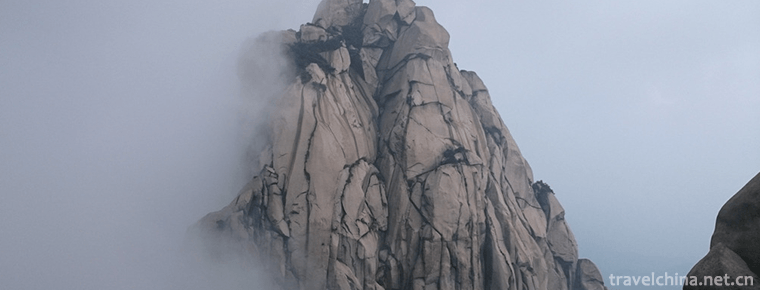
-
Guyang Qincheng Great Wall Site
The site of the Qincheng Great Wall in Guyang is located in the Yinshan Mountains in the central part of Inner Mongolia Autonomous Region, along the Damiao, Yinhao and Xidoupu in the northern part of .
Views: 118 Time 2019-01-12 -
West Mountain Scenic Spot of Guiping
Guiping Xishan Scenic Spot, National AAAA Scenic Spot, National Geopark. Located in Guiping City, southeastern Guangxi Zhuang Autonomous Region, Xishan Scenic Spots 1 km away from the outskirts of the.
Views: 117 Time 2019-01-13 -
Maling River Canyon
Maling River Gorge is located in Xingyi City, Guizhou Province. It is an important member of Xingyi National Geopark and a national scenic spot of the People's Republic of China. It is known as ".
Views: 269 Time 2019-02-06 -
Kirgiz costumes
"Kirgiz" means the people who live on the cliffs. Another saying is that "Kirgiz" are forty girls. This statement is wrong. Most of the Kirgiz people live in Xinjiang's Kizilesu Au.
Views: 263 Time 2019-05-09 -
Brush making skills
Brush making skills, local folk traditional skills in Huangpu District of Shanghai and Jiangdu District of Yangzhou City of Jiangsu Province, one of the national intangible cultural heritage..
Views: 174 Time 2019-05-24 -
Nazikum
Nazikum is a folk dance performance that combines instrumental performance, competitive performance, mime performance and rap. The unique squatting dance is the leading style in Uygur folk songs and d.
Views: 141 Time 2019-06-07 -
Woodbugle
Forest chant is a traditional folk song in Northeast China. It is a kind of song sung by woodcutters who are engaged in carrying wood in the forest. As the saying goes, "trumpet". At present.
Views: 90 Time 2019-06-12 -
Sizhou opera
Sizhou Opera is one of the four major operas in Anhui Province. Its original name is Lahun Opera. It has a history of more than 200 years. Many people think that it originated in Haizhou, northern Jia.
Views: 120 Time 2019-06-16 -
The eldest son drum book
The eldest son drum book is the traditional art of rap and singing in Shanxi Province. Changzi County is known as the "Town of Quyi", which has a long history as well as a wide variety of Qu.
Views: 389 Time 2019-07-25 -
The evolution of Guangyuan
Guangyuan was ruled by Yin state in Xia Dynasty and Ju state in Zhou Dynasty. At that time, the state of Ju was in a state of tripartite confrontation with the states of BA (governing Chongqing) and Shu (governing Chengdu)..
Views: 300 Time 2020-12-15 -
Yibin economy
In 2019, Yibin City will realize a GDP of 260.189 billion yuan, an increase of 8.8% over the previous year in terms of comparable prices. Among them, the added value of the primary industry was 27.764 billion yuan, an increase of 2.9%; the add.
Views: 282 Time 2020-12-18
